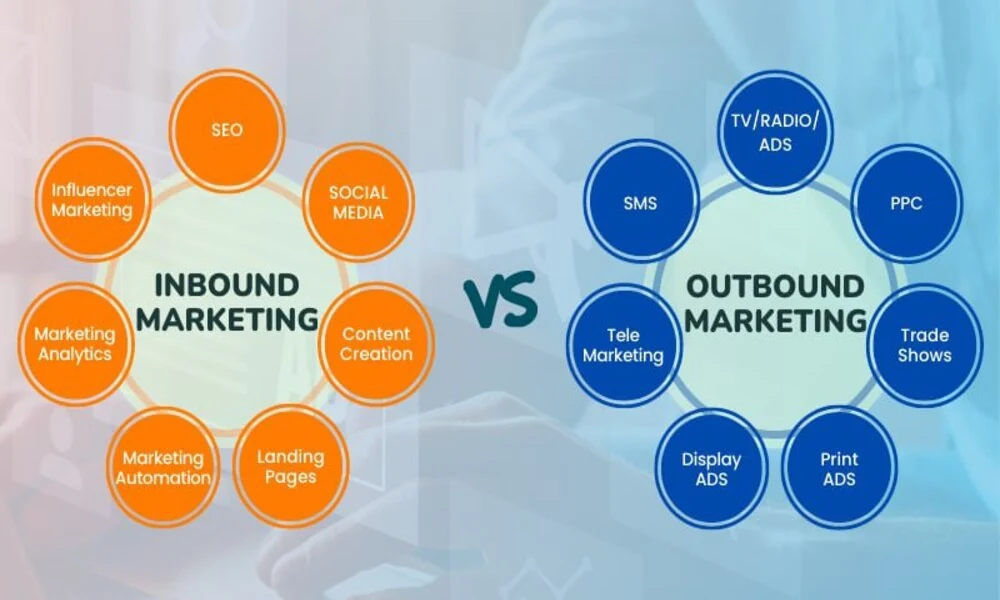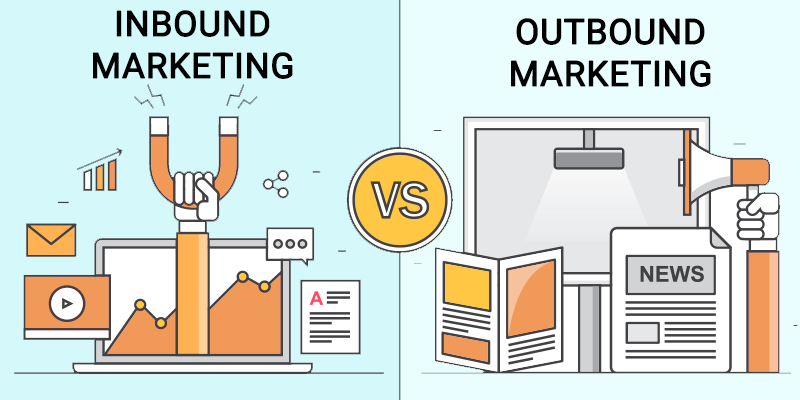Business
Inbound vs Outbound Marketing: Which Strategy Is Right For Your Business?

Introduction: Understanding the Battle between Inbound vs Outbound Marketing
Are you struggling to determine the most effective marketing strategy for your business?
In today’s competitive landscape, choosing between inbound and outbound marketing can make a significant impact on your overall success.
In this article, we will dive deep into the inbound vs outbound marketing debate, highlighting their differences, benefits, and drawbacks.
By the end, you’ll clearly understand which approach aligns best with your business goals.
Benefits and Drawbacks of Inbound Marketing
Benefits of Inbound Marketing
- Inbound marketing creates a strong online presence and brand authority.
- It generates high-quality leads through targeted content.
- It fosters meaningful engagement and long-term customer relationships.
- Inbound marketing allows for better tracking and measuring of campaign effectiveness.
- It is cost-effective in the long run, as content continues to attract and engage customers over time.
Drawbacks of Inbound Marketing
- Inbound marketing requires a significant investment in time and resources.
- It may take time to see substantial results and a return on investment (ROI).
- Competing for visibility and standing out in a saturated digital market can be challenging.
- Constantly producing high-quality content can be demanding for businesses with limited resources.
Benefits and Drawbacks of Outbound Marketing
Benefits of Outbound Marketing
- Outbound marketing offers immediate visibility and exposure.
- It allows businesses to reach a wide audience, increasing brand awareness.
- Traditional outbound techniques like television and radio ads can target specific demographics effectively.
- Outbound marketing can be particularly effective for time-sensitive promotions and events.
Drawbacks of Outbound Marketing
- Outbound marketing can be costly, especially for small businesses.
- It often interrupts consumers’ activities and can be seen as intrusive.
- With the rise of ad-blocking and streaming services, outbound marketing may reach a diminishing audience.
- Outbound marketing lacks the personalized touch and relationship-building aspect of inbound marketing.
Inbound Marketing: Engaging Customers Through Valuable Content
Inbound marketing revolves around creating valuable content that attracts and engages potential customers. It focuses on building strong relationships and establishing trust with the target audience.
Let’s explore the key aspects of inbound marketing:
1. The Power of Content Creation
Inbound marketing relies heavily on content creation. Blog posts, articles, videos, and social media content are all integral parts of an inbound marketing strategy.
Businesses can attract qualified leads by providing valuable information, solving problems, and addressing customer pain points.
2. Search Engine Optimization (SEO)
One of the pillars of inbound marketing is SEO. By optimizing your website and content for search engines, you can increase organic traffic and visibility.
You can position your business as an authority in your industry through keyword research, on-page optimization, and link building.
3. Lead Generation and Conversion
Inbound marketing aims to generate leads and convert them into loyal customers.
Calls-to-action (CTAs), landing pages, and lead magnets, such as ebooks or webinars, capture visitors’ information and nurture them through the sales funnel.
4. Social Media Engagement
Engaging with your target audience on social media platforms is fundamental to inbound marketing.
You can establish a strong brand presence and foster customer loyalty by creating compelling social media content, actively responding to comments and messages, and building an online community.
5. Personalization and Customer-Centric Approach
Inbound marketing emphasizes personalization and understanding customer needs.
You can build long-lasting relationships with your customers by segmenting your audience and delivering tailored content, offers, and experiences.
Outbound Marketing: Reaching Out to Potential Customers
Outbound marketing, also known as traditional or interruption marketing, involves reaching out to potential customers through various advertising channels.
It relies on pushing messages to a wide audience to capture their attention. Let’s explore the key aspects of outbound marketing:
1. Television and Radio Advertising
Television and radio commercials are classic examples of outbound marketing. By broadcasting messages to a large audience, businesses can create brand awareness and generate leads.
However, the effectiveness of this approach heavily depends on the target audience and the timing of the advertisements.
2. Print Advertising
Print advertising, such as newspaper ads and billboards, is another form of outbound marketing. While it offers wide reach, it may not provide the same level of targeting and personalization as inbound marketing approaches.
3. Telemarketing
Telemarketing involves making phone calls to potential customers to promote products or services.
While it can be an effective outbound marketing strategy, ensuring compliance with relevant regulations and avoiding annoying or intrusive practices is crucial.
4. Direct Mail
Sending physical mail, such as brochures or catalogs, to a targeted audience is a common outbound marketing tactic.
This approach allows businesses to reach potential customers directly, but it requires careful targeting to avoid wasting resources on uninterested recipients.
5. Trade Shows and Events
Participating in trade shows and events provides opportunities for businesses to showcase their products or services to a specific target audience.
Outbound marketing efforts at these events include booth displays, presentations, and direct engagement with attendees.
Conclusion: Finding the Right Marketing Mix
There is no one-size-fits-all solution in the battle between inbound vs outbound marketing. The best approach depends on various factors, including your target audience, industry, budget, and marketing goals.
By understanding each strategy’s unique characteristics, benefits, and drawbacks, you can make an informed decision and create a marketing mix that aligns with your business objectives.
Remember, inbound marketing focuses on attracting and engaging customers through valuable content, while outbound marketing involves reaching out to potential customers through traditional advertising channels.
Consider your resources, target audience preferences and long-term goals to strike the right balance and maximize your marketing efforts.
Inbound vs Outbound Marketing: FAQs
- Which marketing strategy is more cost-effective? Inbound marketing is often considered more cost-effective in the long run. While it requires an investment in content creation and SEO, it has the potential to generate consistent organic traffic and leads without ongoing advertising costs.
- Which approach provides better targeting capabilities? Inbound marketing offers superior targeting capabilities compared to outbound marketing. By leveraging audience segmentation, personalized content, and data analytics, businesses can reach specific customer segments and tailor their messaging accordingly.
- Which strategy is more suitable for small businesses? Inbound marketing is generally more accessible and adaptable for small businesses with limited budgets. It allows them to compete on a level playing field by focusing on creating valuable content and building relationships with their target audience.
- Can inbound and outbound marketing be used together? Yes, combining inbound and outbound marketing strategies can create a powerful marketing mix. By leveraging the strengths of both approaches, businesses can maximize their reach and engagement with the target audience.
- How long does it take to see results with inbound marketing? Inbound marketing is a long-term strategy that requires consistent effort and patience. While some results, such as increased organic traffic, may be visible within a few months, it typically takes six to twelve months to see significant improvements in lead generation and customer acquisition.
- Is outbound marketing becoming obsolete? While inbound marketing has gained significant popularity in recent years, outbound marketing still has its place in certain industries and target markets. It’s important to evaluate your specific business needs and target audience preferences to determine the most effective marketing approach.
RELATED CTN NEWS:
Breaking Boundaries: How Outbound Marketing Can Take Your Brand To New Heights
YouTube SEO: Unlocking The Power Of Video Optimization
Business Logo Ideas: Creating A Memorable Identity For Your Brand



















![Play Online Blackjack In Australia [2024]: Top 10 Online Australian Blackjack Sites 22 Play Online Blackjack in Australia [2024]: Top 10 Online Australian Blackjack Sites](https://www.chiangraitimes.com/wp-content/uploads/2024/03/word-image-303235-1-80x80.jpeg)












